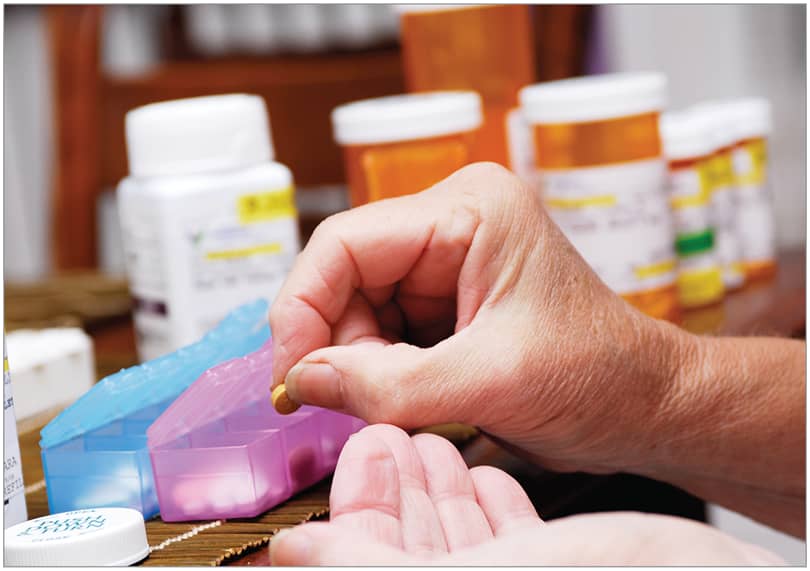Seasons change, fashions change, US presidents change, but for many patients, prescriptions never do—except to become more numerous.
Among US adults aged 40 to 79 years, about 22% reported using 5 or more prescription drugs in the previous 30 days, according to data from the National Center for Health Statistics (NCHS), part of the US Centers for Disease Control and Prevention.
Polypharmacy, where a person regularly takes 5 or more prescription drugs, has become more common.
At age 84, Elizabeth Thaler of Rochester, New York, was lucky. Her daughter and son-in-law lived nearby and noticed when her memory began to slip, and she became too weak to cook. Soon she stopped getting out of bed.
Medications are meant to help, not harm. But sometimes, taking too many drugs can be dangerous, especially for older adults.
Read on to learn about NIA’s support for polypharmacy research and how our work in this area can help ensure older adults take only those medicines they need to help them live full, healthy lives.
Polypharmacy — taking five or more meds at a time — leads to side effects, unnecessary hospitalizations and premature deaths. Researchers and pharmacists are seeking solutions to this serious public health problem that disproportionately affects older adults.
When my grandmother Carol Mitchell was diagnosed with Parkinson’s disease in 2010 at the age of 72, she was prescribed a drug called carbidopa/levodopa. She swallowed the little oblong pill four times a day — 7 a.m., 11 a.m., 3 p.m. and 7 p.m.
Dr. Sascha Dublin explains why sometimes not taking medications may be a safer and healthier choice.
Recently, The New York Times posted a story about a common danger for older adults — taking more medications than necessary. I read the story with interest because I help lead an initiative it describes: the U.S. Deprescribing Research Network. Our goal is improving medication use and outcomes for older adults.
Older adults often take more medications than they need, or than is safe. Increasingly, geriatric experts and their patients are exploring the benefits of “deprescribing.”
The last straw, for Leslie Hawkins, was her mother’s 93rd-birthday gathering in 2018.
Her mother, Mary E. Harrison, had long contended with multiple health problems, including diabetes and the nerve pain it can cause; hypertension; anxiety; and some cognitive decline. She was prone to falling.
When you’re thinking about taking a new medicine, the list of possible side effects can look endless—and scary. Drug labels list an average of 70 (and as many as 525), according to one study.
“The more medications a person takes, the greater the chance at least one will cause an adverse effect,” says Michael Steinman, M.D., a professor of medicine in the geriatrics division at the University of California, San Francisco, School of Medicine. “Plus, medicines can interact with each other such that the combination causes problems.”
- Experts say many older adults who are taking a number of prescription pills can develop a “medication fog” that mimics dementia symptoms.
- Experts say pain medications, sleep medications, and antidepressants are some of the prescriptions that can cause this fog.
- Experts say older adults and their caregivers should research medications as well as set up an appointment with a doctor to specifically discuss the prescriptions.
“Tell me about the problems you have with your medications.” A simple open-ended question that is probably rarely asked, but goes beyond the traditional problems that clinicians worry about, like non-adherence, inappropriate prescribing, and adverse reactions.
What do you find when you go deeper? Well we talk with Francesca Nicosia and Mike Steinman about the work they have done around deprescribing and medication related problems…
Claire Dinneen’s daughters thought that worsening dementia was causing her growing confusion, but her doctor suspected something else.
Dr. Pei Chen asked them to round up medicines in the 89-year-old woman’s home and they returned with a huge haul. There were 28 drugs ordered by various doctors for various ailments, plus over-the-counter medicines. Chen spent a year sorting out which ones were truly needed and trimmed a dozen…
More than 40 percent of U.S. adults aged 65 and older take five or more prescription drugs. That’s according to a 2017 report from the U.S. Department of Health and Human Services, which found that so-called “polypharmacy” is on the rise. But some experts are concerned about the medical risks of overprescription, which can happen when patients rely on automated refill services or see multiple specialists. We’ll talk to UCSF’s Michael Steinman…

Here’s a familiar sight in many doctors’ offices after the holidays: Someone shows up with an older family member and dumps the contents of a paper bag filled with medications onto the exam table — drugs they’ve found in their parent’s or grandparent’s medicine cabinet during a Christmas visit…












